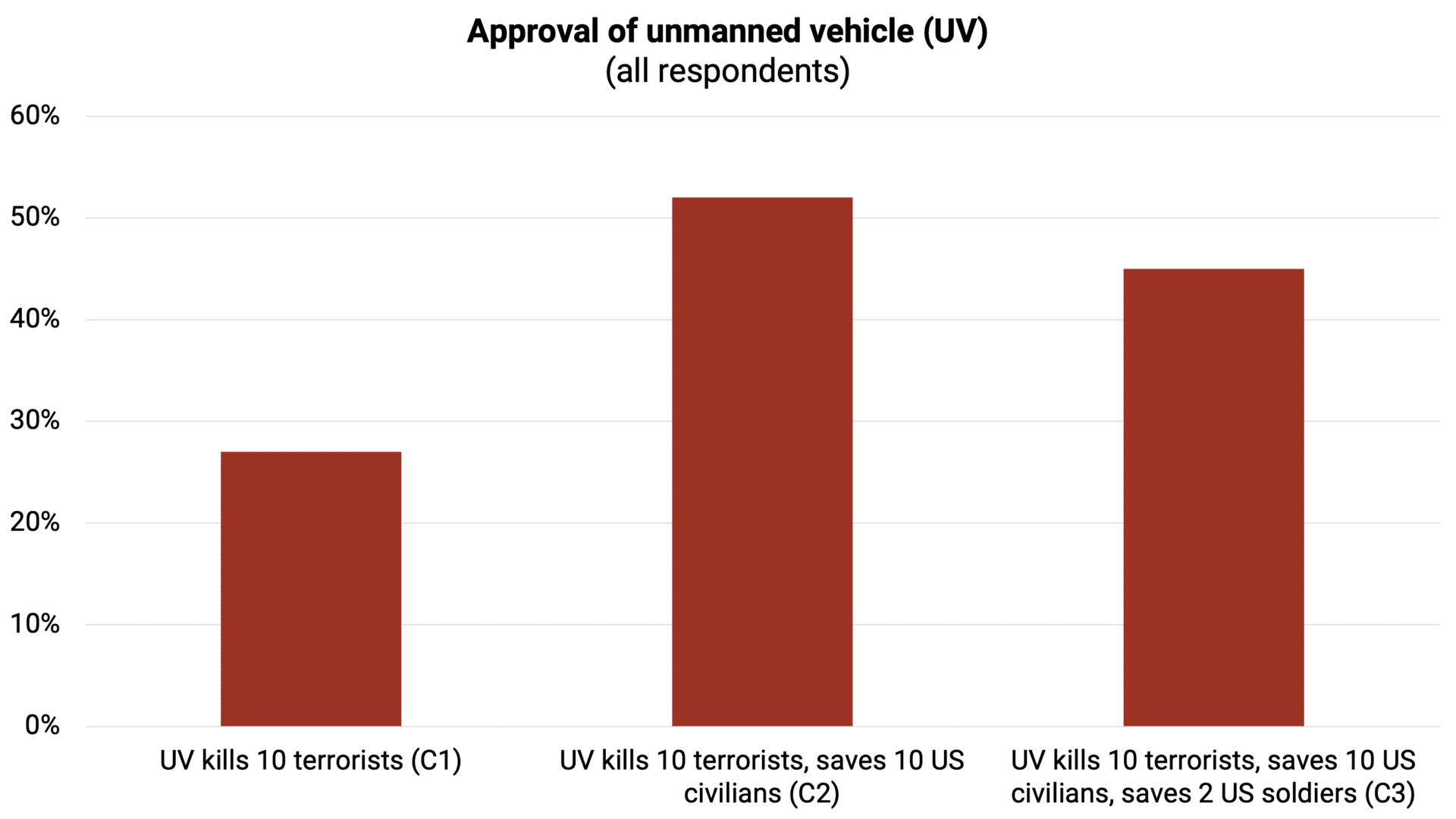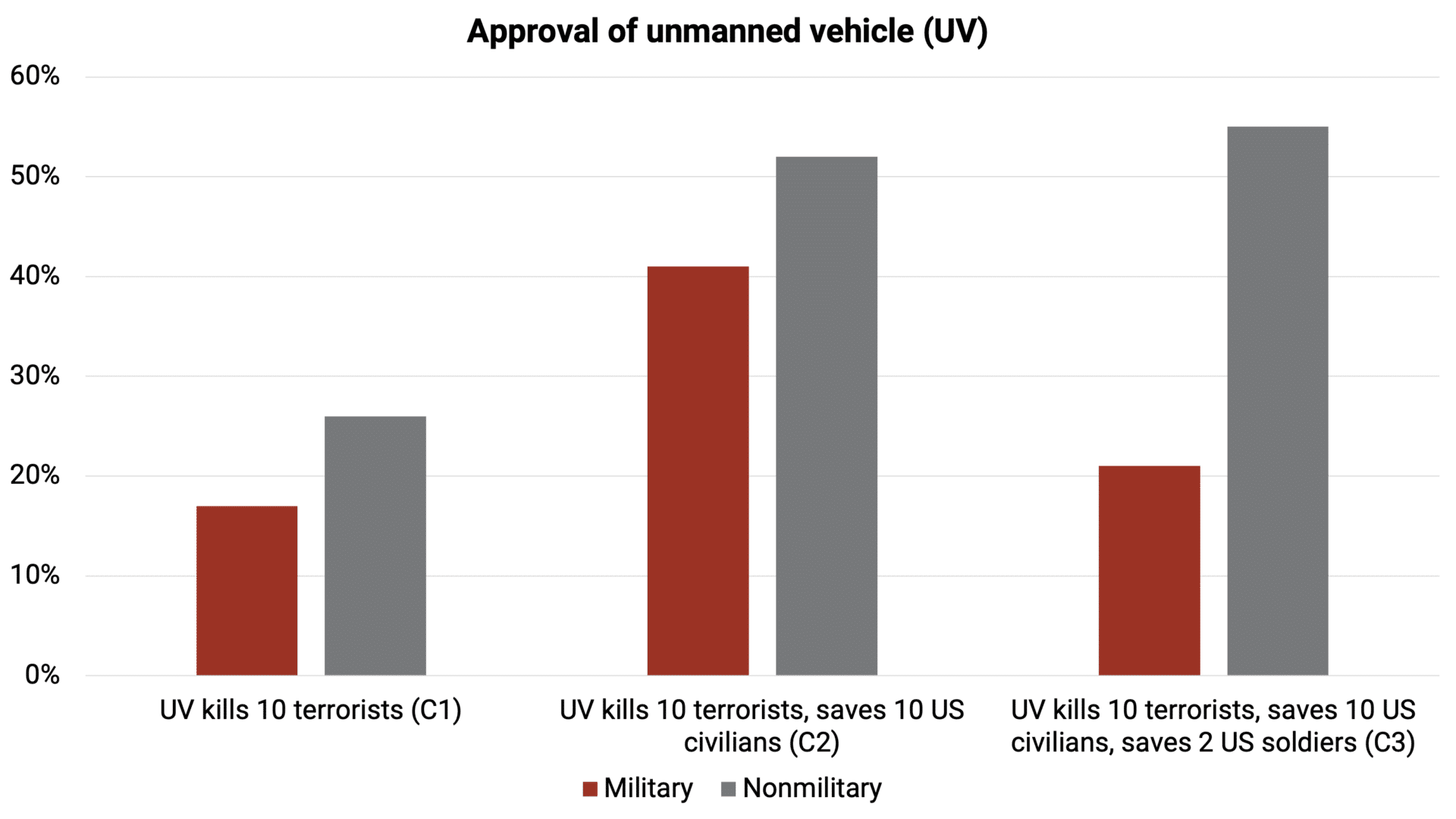Listen up, UN: Soldiers aren’t fans of killer robots
By Catherine Sarkis | April 17, 2024
 US Army soldiers on their way to an oil production facility in Syria in 2020. Behind them are two manned Bradley Fighting Vehicles. Credit: US Army/Spc. Jensen Guillory
US Army soldiers on their way to an oil production facility in Syria in 2020. Behind them are two manned Bradley Fighting Vehicles. Credit: US Army/Spc. Jensen Guillory
According to US Secretary of Defense Lloyd J. Austin, artificial intelligence will be “fundamental to the fights of the future.” AI-powered lethal autonomous weapons, which can select and engage targets without intervention by a human operator, have already been used in modern conflicts, including those in Libya, Ukraine, and Gaza. Also, the US Department of Defense is actively accelerating its efforts to develop autonomous capabilities through programs such as the Replicator Initiative.
While critics of lethal autonomous weapons assert that they could lead to a loss of accountability and meaningful human control, proponents contend that these concerns are outweighed by the potential to save US soldiers’ lives by removing them from the battlefield.
However, a survey experiment I conducted in April 2023 found new evidence that the US public opposes the use of lethal autonomous weapons, even when they save soldiers’ lives. Moreover, my findings suggest that members of the US military are even more opposed to the use of lethal autonomous weapons than the general public. This is paradoxical, as these weapons could have life-saving benefits specifically for the military.
Existing empirical research. Although the ethical issues raised by lethal autonomous weapons have been extensively discussed, empirical research examining American public attitudes toward these weapons is scarce and has methodological flaws.
Existing survey experiments show that the US public tends to oppose the use of lethal autonomous weapons. In what appears to be the first survey experiment on this, in 2008 Ronald Arkin and Lilia Moshkina of the Georgia Institute of Technology found that the more autonomous a weapon is, the less the US public accepts it. Similarly, in a 2013 survey experiment, Charli Carpenter of the University of Massachusetts Amherst found that most Americans oppose autonomous weapons and are in favor of banning them—55 percent and 53 percent of participants, respectively. More recently, in May 2022, in a detailed survey experiment, Ondrej Rosendorf, Michal Smetana, and Marek Vranka of Charles University in Prague sought to measure how various degrees of weapon autonomy affect the US public’s approval of strikes resulting in collateral damage. They found that the more autonomy associated with a strike, the lower its public approval, again illustrating the public’s general opposition to lethal autonomous weapons.
However, these survey experiments are problematic as a measure of US public attitudes toward lethal autonomous weapons. They define these weapons in a vacuum, devoid of context, when asking respondents for their opinions. Context is crucial, though. In particular, considering the legal legitimacy of autonomous weapons, and the numbers of civilians likely to be killed and soldiers likely to be saved in a military operation, is necessary to get a more accurate measure of popular support.
A new assessment of US public opinion. To gain deeper insights into American attitudes toward lethal autonomous weapons, I conducted a survey experiment. My approach was to split representative samples of participants into different groups, and present each group with a hypothetical scenario in which only one variable was altered. This method allowed me to measure the effect of that variable on public opinion. I first divided 450 participants into three groups of 150 each. All participants read the following hypothetical story:
US intelligence officials believe that 10 terrorists are planning to cross the Canadian-US border on snowmobiles this week, each carrying a small grenade that will kill 5 innocent American civilians. There are innocent Canadian civilians snowmobiling along the border, however, and the US does not want to harm them. The US military has presented two options to the president:
A) Send vehicles manned with US soldiers to patrol the border and seek to stop and kill the 10 terrorists; OR
B) Send unmanned armed vehicles to patrol the border and seek to stop and kill the 10 terrorists.
Participants were asked which military option they preferred: using a manned vehicle or an unmanned vehicle. Each of the three groups was given a different set of conditions—or fatal casualty outcomes—for the manned and unmanned options, as summarized in the following table:
Conditions Manned Vehicle Unmanned Vehicle 1 10 terrorists 10 terrorists 2 8 terrorists
10 innocent US civilians*3 8 terrorists
2 US soldiers
10 innocent US civilians**killed by 2 remaining terrorists
Through this design, the survey aimed to test how US attitudes toward lethal autonomous weapons change depending on a military operation’s effectiveness—the number of terrorists, US civilians, and US soldiers killed.
The survey sample had a higher proportion of men than women and was split almost evenly between Democrats and Republicans. Moreover, 52 percent of the respondents stated they “have served or [are] serving in the United States military.” I included an overrepresentation of military members in the sample to enable a comparison of their viewpoints with those of the general public. The survey findings are illustrated below:
While the approval difference between condition groups 1 and 2 is significant, the difference between condition groups 2 and 3 is not. As shown above, when the manned and unmanned vehicles were equally effective, most respondents preferred the use of the manned vehicle (condition 1). However, when the unmanned vehicle was more effective than the manned vehicle, approval of the unmanned vehicle increased (conditions 2 and 3). This suggests that the US public is more willing to support the use of autonomous weapons when they are more effective at killing legitimate targets and saving US lives than manned alternatives.
Surprisingly, adding two US soldiers to the deaths avoided in condition 3 did not increase approval of the unmanned option compared with condition 2—it even decreased approval. At first glance, this might suggest that the US public does not assign much value to saving the lives of two American soldiers in a military operation. But a deeper dive into the data reveals a more complex story.
US military perspectives on lethal autonomous weapons. Paradoxically, the survey also found that members of the US military are even more opposed to the use of lethal autonomous weapons than the general public—despite the fact that these weapons could save their lives.
The chart below illustrates how participants who are serving or have served in the US military responded to the different conditions. It indicates that military respondents generally expressed less approval of unmanned vehicles than nonmilitary respondents, across condition groups. Interestingly, the disparity in approval rates between the two groups increased in condition 3. In that condition, military respondents were especially opposed to using unmanned vehicles, even though this was the only scenario in which soldiers’ lives were saved. This further demonstrates that US military members themselves do not place significant importance on the life-saving potential of autonomous weapons for the military.
In their open-ended responses, survey participants with military backgrounds stressed the significance of prioritizing civilian lives over their own. One respondent stated that he preferred the manned vehicle, because it would enable soldiers to “eliminate the risk of civilian casualties.” This suggests that military respondents may exhibit a form of “courageous restraint,” a willingness to accept risks to themselves to minimize potential harm to civilians.
The path forward. In recent years, international discussions on lethal autonomous weapons have hit a roadblock, despite persistent advocacy from groups like the Stop Killer Robots coalition pushing for a ban on these weapons. One reason for this is the lack of research on public attitudes toward these weapons.
In September, the debate surrounding the use of lethal autonomous weapons will be a focal point of the 2024 United Nations General Assembly. Government decision makers should consider my new findings. A central argument in global discussions thus far has been that saving soldiers’ lives outweighs the risks associated with autonomous weapons. Policymakers need to know that soldiers themselves don’t buy this argument.
Together, we make the world safer.
The Bulletin elevates expert voices above the noise. But as an independent nonprofit organization, our operations depend on the support of readers like you. Help us continue to deliver quality journalism that holds leaders accountable. Your support of our work at any level is important. In return, we promise our coverage will be understandable, influential, vigilant, solution-oriented, and fair-minded. Together we can make a difference.

















I feel like if this was done again (the survey I mean) they should add more cases, in which only soldiers die, a case where innocent Canadians are caught in the crossfire and also hit, a case where they’re hostages, and a case where, in order to save civilian lives, all the soldiers die. A larger test group would be interesting too, with age and political beliefs included. This was an interesting survey though, I’m glad it was done.